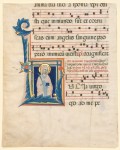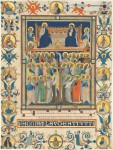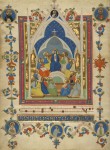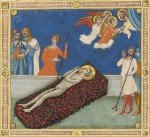 A stolen page from a 14th century illuminated manuscript that has been in the Cleveland Museum of Art since the 1950s is now in the hands of U.S. Immigration and Customs Enforcement’s (ICE) Homeland Security Investigations division in preparation for its return to Italy. Codex D is an antiphonary, a book of chants used by liturgical choirs in the Middle Ages, which was once held by the Church of Saints Ippolito and Biagio in Castelfiorentino, Tuscany, a town about halfway between Florence in Pisa, and is now kept in a Castelfiorentino museum. It’s not certain exactly when, but two illuminated leaves were stolen from the manuscript. One of them was bought by the Cleveland Museum of Art in 1952. It was attributed to a different illuminator at the time and the museum put it on display without realizing there was anything shady about its ownership history.
A stolen page from a 14th century illuminated manuscript that has been in the Cleveland Museum of Art since the 1950s is now in the hands of U.S. Immigration and Customs Enforcement’s (ICE) Homeland Security Investigations division in preparation for its return to Italy. Codex D is an antiphonary, a book of chants used by liturgical choirs in the Middle Ages, which was once held by the Church of Saints Ippolito and Biagio in Castelfiorentino, Tuscany, a town about halfway between Florence in Pisa, and is now kept in a Castelfiorentino museum. It’s not certain exactly when, but two illuminated leaves were stolen from the manuscript. One of them was bought by the Cleveland Museum of Art in 1952. It was attributed to a different illuminator at the time and the museum put it on display without realizing there was anything shady about its ownership history.
ICE only got involved recently when the second leaf from Codex D appeared on the art and antiquities Swiss market. That leaf was repatriated to Italy, but the investigation into its theft and recovery led to the leaf in Cleveland.
Working collaboratively with HSI to research the history of the leaf and after evaluating the information provided by the Italian government, the Museum agreed the leaf should be transferred to Italy to be reunited with the Antiphonary.
“Once we were able to substantiate the information provided, we decided that the best place for the leaf was back with the Antiphonary. We feel the leaf has greater significance if it is reunited with the other illuminations in the manuscript. Along with the recovery of a second leaf, the Antiphonary will now be complete” said William Griswold, director of the Cleveland Museum of Art.
 The antiphonary was illuminated by one of the greatest artists of the first half of the 14th century. His name has yet to be discovered, but he is known as the Master of the Dominican Effigies. He was given his moniker by art historian Richard Offner after his magnum opus, a panel painting in the Church of Santa Maria Novella, Florence, entitled Christ and the Virgin Mary Enthroned, Attended by Seventeen Dominican Saints and Beati (beatified or blessed ones). His panel paintings were smaller triptychs and tabernacles characterized by complex narratives rendered on a miniature scale. He was one of a group of Florentine artists in the 14th century classified as painters of the “miniaturist tendency” who sought to capture the dynamism and emotion of life in the details of small scenes.
The antiphonary was illuminated by one of the greatest artists of the first half of the 14th century. His name has yet to be discovered, but he is known as the Master of the Dominican Effigies. He was given his moniker by art historian Richard Offner after his magnum opus, a panel painting in the Church of Santa Maria Novella, Florence, entitled Christ and the Virgin Mary Enthroned, Attended by Seventeen Dominican Saints and Beati (beatified or blessed ones). His panel paintings were smaller triptychs and tabernacles characterized by complex narratives rendered on a miniature scale. He was one of a group of Florentine artists in the 14th century classified as painters of the “miniaturist tendency” who sought to capture the dynamism and emotion of life in the details of small scenes.
 Many of the miniaturists, the Master of the Dominican Effigies prominent among them, were also manuscript illuminators. Indeed, their illumination skills played an important role in the artists’ approach to panel painting. Panels by the Master of Dominican Effigies, for example, have exquisite freeform decorative details created with a stylus rather than the metal rods with patterns on one end, known as punch tools, that were frequently used by Tuscan painters from the early 14th century to stamp decorations onto the work. He did it by hand with what was basically a pen, just like he did in his manuscripts.
Many of the miniaturists, the Master of the Dominican Effigies prominent among them, were also manuscript illuminators. Indeed, their illumination skills played an important role in the artists’ approach to panel painting. Panels by the Master of Dominican Effigies, for example, have exquisite freeform decorative details created with a stylus rather than the metal rods with patterns on one end, known as punch tools, that were frequently used by Tuscan painters from the early 14th century to stamp decorations onto the work. He did it by hand with what was basically a pen, just like he did in his manuscripts.
 The Master was one of the preeminent illuminators of his age and was commissioned by secular and religious patrons to illuminate antiphonaries, hymnals, even copies of Dante’s Divine Comedy. The Laudario of Sant’Agnese, a hymnal he illuminated together with his friend and the other preeminent illuminator of their time, Pacino di Bonaguida, is widely considered one of the most important illuminated manuscripts made in early 14th century Florence. Its pages are scattered in 16 collections in Europe and the United States, four of them in J. Paul Getty Museum.
The Master was one of the preeminent illuminators of his age and was commissioned by secular and religious patrons to illuminate antiphonaries, hymnals, even copies of Dante’s Divine Comedy. The Laudario of Sant’Agnese, a hymnal he illuminated together with his friend and the other preeminent illuminator of their time, Pacino di Bonaguida, is widely considered one of the most important illuminated manuscripts made in early 14th century Florence. Its pages are scattered in 16 collections in Europe and the United States, four of them in J. Paul Getty Museum.
 Because of their rarity and art historical importance, individual pages from manuscripts illuminated by the Master of Dominican Effigies are highly prized and found in a number of top US museums, including the National Gallery of Art as well as the Getty. Even small fragments of his illuminations are considered museum quality and can be found in museums like the Art Institute of Chicago. One of the Getty’s Laudario holdings is a fragment, a cutout of the martyrdom of St. Lawrence by Pacino di Bonaguida.
Because of their rarity and art historical importance, individual pages from manuscripts illuminated by the Master of Dominican Effigies are highly prized and found in a number of top US museums, including the National Gallery of Art as well as the Getty. Even small fragments of his illuminations are considered museum quality and can be found in museums like the Art Institute of Chicago. One of the Getty’s Laudario holdings is a fragment, a cutout of the martyrdom of St. Lawrence by Pacino di Bonaguida.
Only one leaf from of The Laudario of Sant’Agnese is still in Italy, so the return of both stolen leafs from the Codex D antiphonary is a rare and precious thing. ICE and the Italian government are working out the details of the repatriation now.
How nice that Jesus has a “no waiting” policy for the barbecued. I swear it looks as if the perps are discussing whether real bbq uses sauce or not.
On a more serious note, Master of the Dominican Effigies is quite a mouthful- when did artists actually start signing their work (in Europe, that is). Must have been a piety thing?
Excellent blog post! It is always gratifying to see a stolen manuscript leaf repatriated to its country (and manuscript) of origin. Thank you, too, for reproducing the entire panel of Christ and the Virgin Mary Enthroned, Attended by Seventeen Dominican Saints and Beati.